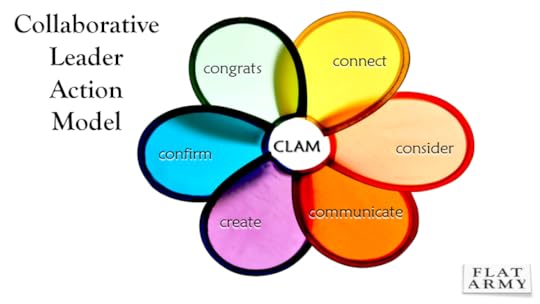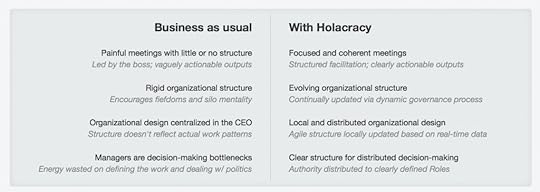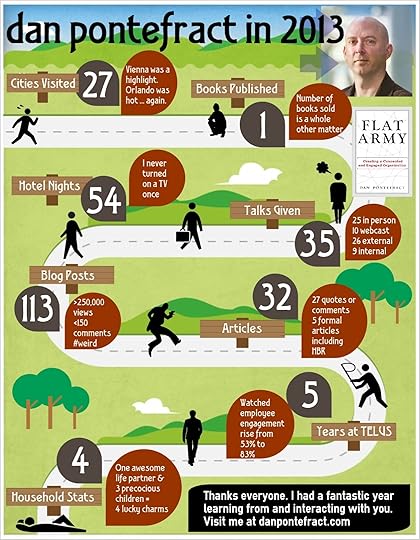Dan Pontefract's Blog, page 43
February 4, 2014
Dear Mister Dylan Benson, you are the Definition of Class

Dylan Benson, whose wife Robyn is now on life-support, said he intends to name their son Iver Cohen Benson. (Dylan Benson/YouCaring.com)
Dear Dylan (aka Mister Benson),
You are the definition of class.
To experience what you have — finding your wife prone, unconscious in the bathroom due to an irreparable cerebral hemorrhage — is heartbreaking. It is, perhaps, without words.
But you are the definition of class.
Recently married is one thing, but to know your wife is carrying your first child — a son, Iver — might be argued as cruelty against humanity. Cruelty against you, your wife and your son, of course.
But due to the work of astute healthcare professionals and technology innovation — not to mention the unending love your wife displays for Iver — your son incubates in relative safety awaiting his first breath. Who could imagine such a scenario?
But you are the definition of class.
First, you didn’t cower or hide behind such unimaginable pain. No, you started a blog.
A blog.
And with your first post — The Day After My Life Changed — you demonstrated humility, honesty and fear with deftness … with courage.
Second, you continued to write. From the update on your wife’s options, to the taxi driver story about lasagna, to the update about a 900 gram viewing of Iver … your resiliency is unteachable, your empathy innate.
Third, you not only write on your blog — and continue to write, openly and with veracity — you agreed to mainstream media interviews through print, radio and television. The CBC interview is one of the most demonstrable displays of humanity I have ever witnessed.
And lastly, by being public and through such unwavering sincerity, you agreed to establish the Baby Iver Fund to benefit your son into the future. That one act moves things to a whole other level of selflessness, such that you are able to provide for Iver in the years to come. Stunning.
You are the definition of class.
I too have a rock and am lucky to have met her. Robyn will be with you and with Iver forever. I know you will continue to be that rock for Iver going forward. He is lucky to have such a strong mother and obviously a compassionate, caring and loving father.
Never forget Mister Benson — and as hard as things may seem now and into the near future — you are the definition of class.
We’re not here to see through each other; we’re here to see each other through.
Sincerely,
Dan
PS. I donated. If you’re not Dylan and are reading this, please consider donating as well.
Dan's Related Posts:Dear Mr. Pontefract – I Need a Connected Learning PlatformThe Iconic Leader: Stage 4 of 5 in the Leadership Tonic ScaleOur Three Young Children Blog … Here’s WhyYou Will Never Be PromotedDear Mr. Machado – A Few Connected Learning Options for You
Can Humanism Replace Capitalism?
 Can humanism replace capitalism? Can capitalism be fought back by a new sense of purpose?
Can humanism replace capitalism? Can capitalism be fought back by a new sense of purpose?
No. Not in my lifetime.
It’s sad. Really, it is.
Can humanism — the concept of value, meaning and purpose — be interwoven in parallel with capitalism?
That *may* have a fighting chance.
We first need to revisit the terms business, company, corporation and capitalism. The word capitalism — the concept of accumulating capital — arrived on the scene in 1854, but of course there has always been the vortex of capitalism. Whether the serfs, aristocrats, feudal land owners, or early mercantiles/merchants … the concept of capitalism has a solid 500+ year history.
But when did we lose the plot? When did capitalism replace the business, company or corporation? When did capitalism become society’s new purpose? (at least the purpose of those pulling the strings)
A business — the original act of being busy — is perhaps a clue. Or perhaps the word company lends us a hand in our quest. After all, a company is to be in ‘company’ with others, no? And what of the corporation? What say you, a word with negative connotations in this the 21st century of uncertainty? From the Latin ‘corporationem‘ it truly means “persons united in a body for some purpose”.
So let’s recap.
To be in business is to keep busy in good company
with persons united in a body for some purpose.
In my humble estimation, capitalism has replaced the business, the company and the corporation.
And we’ve lost our purpose.
Our purpose has ever so swiftly shifted to the accumulation of share; the holder of share, you might say.
We ought to — we must — harken back to a time of the business, the company and the corporation as they are defined for us today and relinquish the magnetic draw that is capitalism and by extension shareholder value.
We are all to blame though. Partially at least. Capitalism is the ugly, older step-sister to the triplets known as materialism, consumerism and individualism. We feed the beast by our unadulterated need for stuff.
In 1933, America instituted the “New Deal”, a series of economic programs to assist the working class get back on its feet after the Great Depression. It revolved around what was referred to as the “3 Rs”: Relief, Recovery, and Reform. That is Relief for the unemployed and poor; Recovery of the economy to normal levels; and Reform of the financial system to prevent a repeat depression. We either need a new New Deal — a new definition for a new world order — or workers are going to begin thinking they are in a “Raw Deal”.
John Maynard Keynes wrote in 1930:
“Now it is true that the needs of human beings may seem to be insatiable. But they fall into two classes — those needs which are absolute in the sense that we feel them whatever the situation of our fellow human beings may be, and those which are relative in the sense that we feel them only if their satisfaction lifts us above, makes us feel superior to, our fellows.”
Truer words could not have been written today in 2014. We suffer in part because we have no idea what workplace or financial happiness ought to look like. Shareholder value has become the new normal.
Paul Polman, CEO of Unilever — one of the world’s leading suppliers of consumer goods be it foods, home care or personal care — believes the time has come for corporate sanity. In an interview with The Guardian newspaper, Polman stated:
“The very essence of capitalism is under threat as business is now seen as a personal wealth accumulator. We have to bring this world back to sanity and put the greater good ahead of self-interest. We need to fight very hard to create an environment out there that is more long term focussed and move away from short termism.” (The Guardian, Jo Confino, Thursday 21 June 2012)
Paul is spot on.
You may have asked the question “what is the purpose of these corporations from society’s point of view?”
The bigger question is “what will be the new purpose of these corporations?”
Dan's Related Posts:Flat Army Book Excerpt: Organizational Learned HelplessnessCoaching Should Be An Expectation Of All Connected LeadersThe TED of all Leadership Management Conferences – A Review of the Drucker Forum…Steve Denning Nails It on Forbes: Paradigm Shift in Leadership and ManagementRSS Behaviour Redefined: Rhizophilous Social Sources
January 27, 2014
Which Type of Stonemason Are You?
 Here’s an old story about three different stonemasons from a bygone era. We’ll call them Mario, Paladino and Antonio.
Here’s an old story about three different stonemasons from a bygone era. We’ll call them Mario, Paladino and Antonio.
They each are working on the construction of a new building. Technically they’re on the same team, but it’s their attitudes that I’m interested in.
When we ask Mario what he’s working on, he frowns and says with a hint of sarcasm:
“My job is to take these bloody awful stones, chip them down so they fit into the open slots on that wall over there, and hope like Hell they don’t fall on someone. I’m just doing what my boss tells me to.”
Paladino chimes in rather bluntly:
“I’m a stonemason. I’m building that wall over there.”
But Antonio is a wee bit different. He takes a sip of water from his canteen, wipes his lips and then a smile begins to develop from ear to ear across his five o’clock shadow face. With vigor and passion, Antonio asserts:
“I am part of a team that is building a fantastic place of worship for the masses to enjoy for all eternity. We know this Cathedral will become a symbol of community and as each stone gets laid, we get closer to our goal of bringing people together.”
And it begs the questions, which type of stonemason are you?
Dan's Related Posts:Flexible Working WorksFriday Fun: The Difference b/t Apple & Microsoft Is …Dear Mr. Pontefract – I Need a Connected Learning PlatformThe Link Between Leadership, Learning & Organizational PerformanceRedefining the Social Employee
January 22, 2014
The First Step To Improving Employee Engagement Is To Connect With Your Team
 I used to live at the corner of Robson Street and Howe Street in downtown Vancouver. It was a splendid rooftop, corner suite flat facing Northwest with a view overlooking the Vancouver Art Gallery, itself a wonderful piece of architecture.
I used to live at the corner of Robson Street and Howe Street in downtown Vancouver. It was a splendid rooftop, corner suite flat facing Northwest with a view overlooking the Vancouver Art Gallery, itself a wonderful piece of architecture.
Well, it was a splendid flat until we started having offspring — who now outnumber Denise and I in a household that is now a helpless facsimile of zone defence gone mad — so we eventually moved to the once über hippie neighbourhood of Kitsilano.
Below the flat was a rather large bookstore. Denise and I treated it like a library. Instead of taking out the books as you would in a library we’d bring our own bookmarks, hide the books we were reading, fetch them when we returned while continuing on to sip extra hot lattes in superbly comfortable beanbag chairs.
It was a blissful, carefree life until the goats took over our ‘dual income no kids‘ rodeo.
Anyway, in this bookstore (ahem, library) I witnessed a remarkable leadership action occur on more than one occasion.
Bookstore management (aka. leadership) actually asked the various staff members working in the shop for their opinion.
Amazing, isn’t it?
The manager would huddle together with the employees and begin a short discussion with them about issues like book displays or signage or even the location of chairs and bean bags.
 The manager was in fact ‘connecting‘ with his or her team to solicit feedback and ideas on how best to operate the bookstore. (connecting, of course, is the first stage in the Flat Army ‘Collaborative Leader Action Model’)
The manager was in fact ‘connecting‘ with his or her team to solicit feedback and ideas on how best to operate the bookstore. (connecting, of course, is the first stage in the Flat Army ‘Collaborative Leader Action Model’)
Amazing, isn’t it?
How do you think the team felt?
Were they inclined to be more engaged, stay the same or would they become disengaged?
The simple act of connecting first with your team to surface ideas, options and alternate views to your own (as the leader) is such a simple behaviour to establish at an organization — as an enterprise-wide norm — it shocks me that it’s still not done more pervasively today.
How hard is it to connect first and consider options before creating the end result?
Gallup finds global employee engagement in 2013 sits at a paltry 13%.
AON Hewitt report 40% of employees are actively or passively disengaged.
BlessingWhite believes only 40% of global employees are actually engaged.
Whichever organization that is studying employee engagement you fancy, the data doesn’t lie.
Employees are not at a level of engagement that is conducive to feeling good about their place of work and thus organizations are left with productivity losses, attrition/absence issues as well as stagnating business growth.
Let’s not get into whether or not the employee is recommending his or her friends to utilize said service or to even contemplate working at the firm.
My theory?
The simple act (the first step) is to ‘connect’ with your team members and ask them to be involved in the operation of your team, your business and your organization.
The employees may not be involved in the final decision, but at least they are involved, at least you are connecting with them … and to me, that is the very essence of being ‘engaged’.
Dan's Related Posts:That Decision Is Above My Pay-GradeEmployee Engagement is Still Poor but it Does Drive Bottom Line ResultsThe Social C-SuiteWhat is Engagement Anyway?The Harmonic Leader: Stage 5 of 5 in the Leadership Tonic Scale
January 16, 2014
Great Work Interview – Flat Army & Michael Bungay Stanier
 I had the chance to sit down and be interviewed by Michael Bungay Stanier, Senior Partner of Box of Crayons, a company that helps organizations do less Good Work and more Great Work.
I had the chance to sit down and be interviewed by Michael Bungay Stanier, Senior Partner of Box of Crayons, a company that helps organizations do less Good Work and more Great Work.
I know, how cool is that tagline?
Michael asked if he could interview me as part of his Great Work interview series. We had a blast. Take a look below at Michael’s overview, thoughts and of course an audio version of the interview itself. Enjoy!
______________________________________
My guest today is Dan Pontefract, who’s Head of Learning of TELUS. Dan has a lot of really practical experience thinking about how to get people aligned in doing meaningful work that makes a difference. He’s also speaking at the upcoming HRPA Conference.
His new book, Flat Army: Creating a Connected and Engaged Organization, is a really powerful read that introduces five or six of Dan’s original models on how he sees the world. So we’re going to uncover some of the real issues around employee engagement and how to do things differently.
In this interview, Dan and I discuss:
The fundamental error in treating employees like numbers (or gladiators)
The need for connected leaders who are equally involved in “becoming, being and going beyond”
Why trust is crucial to organizational success
How to increase people’s capacity to trust
The role of collaboration in creating employee engagement
The 3-33 learning model
(Scroll down for more in-depth podcast notes.)
Listen to my interview with
 Dan Pontefract.
Dan Pontefract.0:00:00: Dan outlines his background in education, and explains that one of the main things he works to change in organizations is their tendency to treat employees like mere numbers – or “gladiators” in a Roman army.
0:05:02: Michael and Dan discuss some of the few positive examples of organizational change, and note that many people are afraid to change. Dan introduces the notion of the “connected leader.”
0:10:03: Dan explains that a connected leader must be equal parts “becoming, being and going beyond.” They don’t just focus on execution, but also on the foundation that leads to execution, and the results of having executed. Michael asks about crucial foundational behaviours, and Dan explains that trust is at the root of organizational success. They discuss how to increase people’s capacity to trust.
0:15:00: Expanding on the importance of establishing trust within an organization, Dan and Michael discuss the need for collaboration and looking beyond the manager-subordinate relationship.
0:20:05: Dan and Michael talk about why leaders should focus on engaging people who actively want a purposeful career, rather than those who are disenfranchised by the system.
0:25:02: In response to Michael’s question about the 70-20-10 learning model, Dan explains his own 3-33 learning model. Michael wraps up by directing listeners to additional resources on Dan and his work.
Dan's Related Posts:The Flat Army Interview with Dan Pontefract’s Three Young ChildrenThe Simple Act of Trustingthe FLAT ARMY cheat sheetApparently, Organizational Culture is CrapThe Fifteen Habits of a Connected Leader
January 13, 2014
The Simple Act of Trusting
In the book Start with Why: How Great Leaders Inspire Everyone to Take Action, author Simon Sinek states:
“Leadership is the ability to rally people not for a single event, but for years. Leadership requires people to stick with you through thick and thin.”
 Although I wholeheartedly agree, one might argue the only way that level or type of loyalty can manifest occurs when leaders unilaterally trust their people, their team and their organization to do what’s right—and to do what’s right always. And when something is not done right, when there is an error in the process or something happens to go sideways such that the goal isn’t achieved, a good leader reinforces his trust in his people.
Although I wholeheartedly agree, one might argue the only way that level or type of loyalty can manifest occurs when leaders unilaterally trust their people, their team and their organization to do what’s right—and to do what’s right always. And when something is not done right, when there is an error in the process or something happens to go sideways such that the goal isn’t achieved, a good leader reinforces his trust in his people.
Whether a bouquet or a brickbat, whether a high or a low, whether a peak or a valley, whether a success or a mistake, the leader must create an environment that ensures all members of the team (direct or indirect) feel safe not just to do their jobs, but also to break free of them. The members must feel as though they can trust their leader to discuss any part of any process or scenario.The leader must portray herself such that anyone can approach her to ask a question no matter the time and no matter the problem.
The act of trusting is table stakes for any leader.
Trust is not about rules. Trust is not about systems. To be trusting is to be mindful of the human condition.We humans have the capacity for good and evil, for right and for wrong. As leaders, we must be able to trust those in our organizations to explore the human condition through the course of regular business practice. Micro-managing, for example, is merely another name for distrust.
Trust is not merely saying you trust someone. Trust is about actually acting in a trusting manner. It is about those interactions and experiences a leader creates for any situation. A leader may say he trusts the team, but it could in fact be a scenario unknowingly depicted by his team members through the acronym ATNA: all talk, no action. You might talk a big game about trust, but to be trusting happens when there is action—when there is interaction and experience.
Trust is both a noun and a verb. It’s when the word becomes a verb that a leader truly demonstrates the attribute of trusting. It’s when a leader can allow both the good and the bad to surface mixed with the per- mission of action. It’s allowing the human condition to manifest in a business environment.
For a leader to be trusting, she must have belief that whatever the scenario, the team will be capable and willing to achieve the objective. For a team to be trusting of the leader, it needs to possess the tacit belief that she is one of the team, not someone camping out behind a closed office door sitting at a marble desk signing expense reports. To be trusting goes beyond being cooperative.
To be trusting is to be able to act with authenticity and moral good. If, for example, a crisis should emerge, there should be palpable trusting actions delivered.When there is triumph, there should be equal levels of trusting behavior. To be trusting may require time, as trust is so often gained only by being earned. It is impossible for anyone in a peer relationship who does not exhibit selfless acts of trust to become a connected leader in our Flat Army.
To allow for failure is to be trusting.
To celebrate success is to be trusting.
To ride repeated cycles of the mundane and humdrum is to be trusting.
Vulnerability begets trust; trust begets loyalty.
How to be trusting:
You don’t know it all: Listen to the viewpoints of others.
People look to you for direction: Be transparent in your views and actions.
In the game of euchre, everyone hates those who renege: Apply the same thinking to Flat Army.
All talk no action is paralyzing: Less talk and more experience and interaction is fruitful.
Mistakes happen, so encourage them: Harvest and learn for the next suitable scenario.
Sporadic, haphazard mannerisms are loathed: Institute consistency in all of your efforts.
Download this article in PDF format for free.
You can also view it on Scribd.
Flat Army: Creating a Connected and Engaged Organization>
Dan's Related Posts:The Fifteen Habits of a Connected LeaderThe Harmonic Leader: Stage 5 of 5 in the Leadership Tonic ScaleDo You Surround Yourself With No?the FLAT ARMY cheat sheetThe Platonic Leader: Stage 3 of 5 in the Leadership Tonic Scale
January 9, 2014
Holacracy Is Not The Answer To Your Employee Disengagement Issues
If you’re located in parts of North America where it’s been too cold to even blink your eyes lately, you may not have seen the news.
Holacracy is the new black.
Holacracy?
In a nutshell, Holacracy is an organizational structure — initially devised by self-described “recovering CEO” Brian Robertson of HolacracyOne — that purports to do the following:
Holacracy is a distributed authority system – a set of “rules of the game” that bake empowerment into the core of the organization. Unlike conventional top-down or progressive bottom-up approaches, it integrates the benefits of both without relying on parental heroic leaders. Everyone becomes a leader of their roles and a follower of others’, processing tensions with real authority and real responsibility, through dynamic governance and transparent operations.
In a nutshell? Holacracy is a way to operate without the classic ‘command and control’ dogma found in many of today’s organizations.
It even has a constitution you are urged to follow.
Where Did Holacracy Come From?
Holacracy burst on the Twitter water cooler scene in early 2014 mostly as a result of Zappos. At the end of 2013, Zappos CEO Tony Hsieh (never one to remain stagnant with his organization) held a town hall meeting to inform the fine folks who work there that their current organizational structure was being tossed in favour of holacracy by the end of 2014. Apparently they were running a pilot in 2013 with 150 or so employees. It worked so well Tony decided to (eventually) scrap his CEO title and all Zappos employees would do the same under holacracy . Even Twitter co-founder Evan Williams has implemented Holacracy® at his new venture Medium. (and Alexia Bowers does a fine job defining the misconceptions of Holacracy)
And the mainstream media and bloggers then went wild for holacracy. It became the new black.
 Lost in the shuffle (I believe) is the origin of the term holacracy. I didn’t interview Brian, but I’d bet one of my Canucks tickets holacracy got its start back in 1967 when author Arthur Koestler penned the book “The Ghost in the Machine” and where he introduced the term holarchy. An ‘archy’ (as a suffix) is a rule or a government and a holon is both a part and a whole. Put them together and you get a connection of holons equating to what Koestler called a holarchy. Holacracy — at least how I view it — is a connection of roles and tasks (a part and a whole) in an attempt to get whatever matters accomplished in as efficient a manner as possible without the rigidity of bosses, hierarchy and other organizational infractions.
Lost in the shuffle (I believe) is the origin of the term holacracy. I didn’t interview Brian, but I’d bet one of my Canucks tickets holacracy got its start back in 1967 when author Arthur Koestler penned the book “The Ghost in the Machine” and where he introduced the term holarchy. An ‘archy’ (as a suffix) is a rule or a government and a holon is both a part and a whole. Put them together and you get a connection of holons equating to what Koestler called a holarchy. Holacracy — at least how I view it — is a connection of roles and tasks (a part and a whole) in an attempt to get whatever matters accomplished in as efficient a manner as possible without the rigidity of bosses, hierarchy and other organizational infractions.
Holacracy — and what I think is its originating parent, holarchy — however will not solve your organizational disengagement issues. Don’t be fooled. Getting rid of titles, managers/bosses and spraying empowerment across your employees doesn’t fix the core issue of today particularly in long-standing organizations with a history of disengagement. Some might say it’s pouring water on a tire fire.
The core issues in today’s organization don’t require the eradication of bosses per holacracy or the creation of overlapping, self-governing circles. (ie. the holons) What it requires is for employees — bosses or not — to simply become humane.
That’s it.
Employees of any stripe, rank and colour ought to behave better with one another.
But behaviour change for any level of employee is extremely difficult when both ‘manager and subordinate’ (wow, do I loathe those terms) have been so used to the classic ‘command and control’ way of operating.
No one ever said change was easy.
Just ask President Obama about the Affordable Healthcare Act in America.
Yes, holacracy as a principle is a very cool concept — who isn’t for a healthier organization team and structure — but I wouldn’t want you to think it’s the silver bullet for you and/or your organization. (Alexia says as much in her Holacracy misconceptions post)
In particular, I don’t think you should go near Holacracy if your organization is large and/or disengaged.
Debating Holacracy
One example I’ll surface is debating what the fine folks at HolacracyOne (the ‘owners’ of Holacracy®) market on their website:
This graphic suggests to me that holacracy is the aforementioned silver bullet built to completely eradicate bad leadership and arguably poor management.
Really?
If an organization implements holacracy will employees (and thus human beings) suddenly forget that they were once territorial, anti-collaborative, close-minded and less than humane in their behaviour with other employees/humans?
I really don’t think so.
Organizations suck (and disengagement is so prevalent) because both managers and employees have forgotten what it is to be human. We don’t know how to be humane in the organization.
And it really isn’t getting any better.
Let’s professionally debunk each of the four points from the graphic above:
Can meetings be less painful without holacracy? Yes of course, and they can be led by anyone on a team if the right behaviours have been instilled into the organization on the whole to be open and transparent.
Can fiefdoms and silos be broken down without holacracy? Yes of course, but it takes organizational behaviours like collaborating, learning, sharing, participating and reciprocity for it to occur.
Can work patterns be improved across an organization outside of a CEO dominated structure without holacracy? Yes of course, if the perfect balance of push and pull, give and take or perhaps ‘flat army’ are deployed as a type of ethos that everyone adheres to.
Can managers as decision-making bottlenecks become cured without holacracy? Yes of course, and one way is to implement the Collaborative Leader Action Model from the Flat Army framework. Connect, Consider, Communicate, Create, Confirm and Congratulate … six key actions (in that order) that will lead even the most disengaged workforce into the highly engaged ranks.
I know this first-hand based on the results of where I ply my trade during the day.
In Conclusion
To be clear, I’m not against the good work that has come of the holacracy movement or what Medium or Zappos are both undertaking. I am certainly not having a go at the fine folks at HolacracyOne either. Having this type of discussion in the open is refreshing and somewhat surreal compared to the decades of prose written about top-down, rigid hierarchical management structures as the ‘way to manage’.
If you’ve made it this far, I simply wanted to get alongside the holacracy movement and suggest it may not be for your own organization.
It’s my belief organizations are disengaged today because they do not possess the open and collaborative types of participative behaviours that are necessary in today’s society. Holacracy might work for some but it doesn’t address the root issue for a disengaged employee or organization, which is … how can you and your organization become more humane?
What behaviours need to be instilled across your organization at any and all levels such that work can become a ‘work of art’.
Work can feel good even with bosses. It requires, however, a radical behaviour change for all.
Dan's Related Posts:Flat Army Book Excerpt: Organizational Learned HelplessnessApparently, Organizational Culture is CrapFuture Of Work: A Flat Army Of Open Leadership via A.G. LafleyRethinking the Work of LeadershipMy Employee Engagement Advice to a Stranger
January 6, 2014
Communitas: The Word of 2014
We aren’t even close.
It doesn’t matter what report you read, what research you cite or what anecdote you dig up … the problems remain.
Our organizations are being crippled by a combination of gale force winds and tectonic plate drifting. The leadership floor in our organizations is full of useless friction — arguably akin to continental drift — while employees continue to be blow n over by colossal gusts of organizational ineptness.
n over by colossal gusts of organizational ineptness.
This has to stop.
The time has come for harmony in our workplace.
The time has come for Communitas.
But before Communitas — my Word for 2014 — we need to discuss ‘liminality’. Derived from Latin for “a threshold”, liminal stems from the work of Arnold van Gennep, a noted anthropologist from France. In 1909, while researching and penning his most famous book ‘The Rites of Passage‘, van Gennep argued rituals as part of any rite of passage were demarcated into three stages: preliminary, liminality and post-liminality. He wrote that the liminal stage was “a gap between the ordered worlds where almost anything could happen.” In plain English, liminal can be thought of as a transition from one state to another.
But that’s what I want to see in our organizations in 2014. I want to see “almost anything happen” and in particular I want leaders in today’s organizations to begin the shift of leading differently. I want leaders to enter the organizational culture equivalence of liminality. I want us to finally achieve a state of transition between today’s useless friction and leadership ineptness to one of organizational harmony and achievement. It doesn’t have to be (and won’t be) solved in 2014.
And the ‘it’ I refer to is the woeful state of the disengaged and/or not engaged employee. Organizational engagement simply has to enter into a stage of transition. We might coin this stage “organizational leadership liminality”.
And that’s where we pick up the ‘Word of the Year‘ trail again by introducing Victor Turner.
A British anthropologist who applied his trade as a professor at the University of Chicago, Turner delved deep into van Gennep’s work on liminality. Spending legions of his time and testing his theories with the Ndembu tribe in Zambia, Turner believed the liminal stage was a separation from ‘normal social roles’ to contemplate, reinterpret and in fact embrace alternatives to the current status quo. Turner’s definition of liminality includes the following:
During liminal periods of all kinds, social hierarchies may be reversed or temporarily dissolved, continuity of tradition may become uncertain, and future outcomes once taken for granted may be thrown into doubt.The dissolution of order during liminality creates a fluid, malleable situation that enables new institutions and customs to become established.
At its core, Turner argues that liminality represents the opportunity for a group to strip down existing structural status and customs to create new ones through both intellect and spirit. It reminds me of the “Hitachi Spirit”, something I wrote about in Flat Army. The core values Hitachi developed at a point of organizational culture inflection were:
Wa (Harmony, Trust and Respect);
Makoto (Sincerity, Fairness, Honesty and Integrity); and
Kaitakusha-Seishin (Pioneering Spirit and Challenge).
But what does liminality have to do with Communitas — my 2014 Word of the Year?
Turner developed the notion of communitas as a way to define what happens to people when entering the stage of liminality. He believes a sense of solidarity emerges at the liminality stage, backed by feelings of equality, spirit, joy, belonging and overall well-being. These feelings — shared by all — lead to a better future. These feelings permit a shift to the status quo. These feelings dissolve any prior rigid obligations of the old world in favour of a new and authentic manner of behaviour in the new world. These feelings are social. These feelings are cooperative.
Communitas, for 2014 at least, will bring people together to bridge their differences into a singular, common organizational leadership framework. It demystifies hierarchy for the sake of hierarchy and reintroduces humanity into the shared values of one another and the organization. Whilst Turner argues communitas is spontaneous, I argue our organizations must enter into the liminality stage with a preordained might of those gale force winds, to eventually define and achieve a communitas state of organizational culture.
In 2014, our organizations can arrive at communitas such that the organization works as one to define how it can become more humane, more engaged, more soulful, more spirited and more productive. If it does work harmoniously as one to define the manner in which it should be operating, internal employee engagement should begin ticking upward throughout 2015 and beyond. (it might take all of 2014 to get to a state of communitas)
2014 is a transition year for the organization and leadership in general. Limanility is the stage our organizations should be entering. By doing so, we force ourselves to achieve communitas. With communitas, we act as one organization devoid of classes and hierarchies as we define a healthier way in which our organizations should be operating. It’s something Charles Handy would be proud of.
 While German sociologist Ferdinand Tönnies may have coined the term Gemeinschaft — where one’s social network is built by one’s own values, beliefs and role in society — communitas is something bigger. It is our chance to bridge the gap for those that either don’t believe in organizational engagement or who are ambivalent to such a concept.
While German sociologist Ferdinand Tönnies may have coined the term Gemeinschaft — where one’s social network is built by one’s own values, beliefs and role in society — communitas is something bigger. It is our chance to bridge the gap for those that either don’t believe in organizational engagement or who are ambivalent to such a concept.
Communitas is what we ought to strive for in 2014.
Communitas is my Word for 2014.
PS. You may be interested in prior Words of the Year:
2013 – Autotelic
2012 – Interlocutor
2011 – Reciprocity
Dan's Related Posts:In 2014, I Will …Kudos Jacques Godin, an Engaged Air Canada EmployeeSteer Clear of Organizational Leadership TurbulenceAutotelic: The Word of 2013The Harmonic Leader: Stage 5 of 5 in the Leadership Tonic Scale
January 3, 2014
In 2014, I Will …
Write a better book
Find a new publisher (that believes in me)
Convince HBR to feature me more than once
Re-read more Handy and Drucker
Be invited to speak at the Drucker Forum
Visit Europe at least three times
Reach out to those I’ve dearly missed
Respond to more tweets without including the original one (ie. just converse)
Reveal more of my true personality publicly
Become more conscious of where I buy things from
Continue donating money and time to those in need
Accept my weaknesses & celebrate my natural strengths
Temper my ‘quick to judge’ tendencies
Enjoy the opportunity of launching a start-up consulting outfit in an $11 billion company
Align forces with Change Agents Worldwide and other key partners
Read at least twelve books
Tell better stories when I’m speaking
Shift ten pounds of weight around
Learn to take stunning photographs
Pay it Forward more than I did in 2013
Answer every comment on this blog
Assist Denise through her career decisions
Support the goats through yet another transition
“Live well, love always and laugh out loud every day” (© Brian Reid)
Dan's Related Posts:Video Review of Drucker Forum 2013Whose Your Brian Reid?Our Three Young Children Blog … Here’s WhyInterlocutors of 2012 (the goats are better for it)Drucker Forum – Video Update #2 – Day 1 Morning Keynotes
December 11, 2013
Dan Pontefract 2013 Year in Review Infographic
2013 was brilliant.
It was so much fun, I decided to develop an infographic that depicts (some of) the year.
Thanks for dropping by. My network is my net worth.
See you in 2014.
Ancora Imparo.
If you’d like to share the infographic, feel free to.
Embed Link
Web Link
https://s3.amazonaws.com/easel.ly/all...
396 total views, 40 views today
Dan's Related Posts:An Infographic Depicting Learning & Collaboration in ActionThere is Nothing More to Say in 2011 … but ThanksThe Remarkable Leadership Story of Conner & Cayden LongVideo Review of Drucker Forum 2013The ‘Empire Avenue’ Strikes Back






